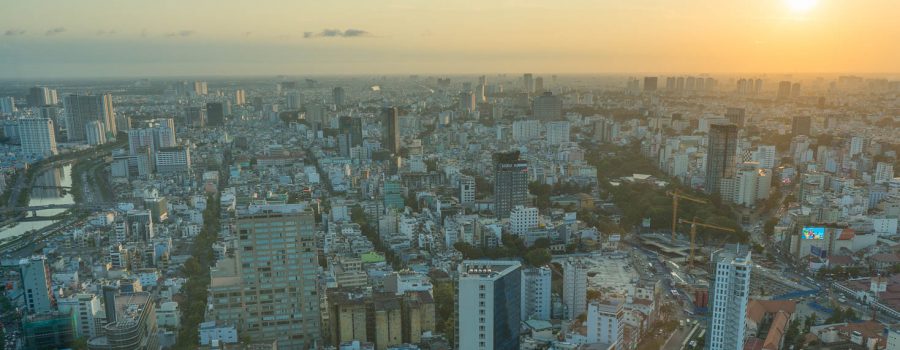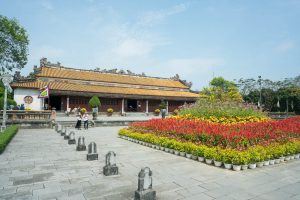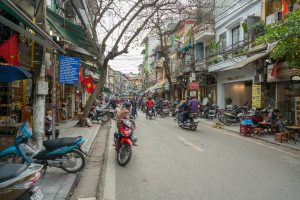Our last stop in Vietnam was Ho-Chi-Minh-City. With a population of over 8 million it is the largest and most important city in Vietnam. While Vietnam’s capital Hanoi in the north welcomed with rather cool temperatures around 20°C, we were welcomed in Ho-Chi-Minh-City by baking hot temperatures of up to 35°C, and the heat amplifies itself through the absence of wind and all the buildings and streets that reflect the heat. The key during our visit in Ho-Chi-Minh-City was to move from one air-conditioned place to the next. During the day we spent a lot of time in shopping malls, cafés, and museums. Only during the night the temperatures were pleasant enough to stay outside.
Museums in Ho-Chi-Minh-City
Two of the museums that we visited were the Independence Palace and the War Remnants Museum. Both display memories from the Vietnam War, and as it was the case in Hanoi’s museum, from a very one-way and patriotic perspective. Nevertheless, after abstracting from the propaganda, we still could get a lot of information out of the museums and seeing the old palace and the military vehicles and planes was interesting.
Independence Palace
When Vietnam was split during the war, the Independence Palace was the residence of the pro-American president of Vietnam and served as government building. On several floors and wings, we could visit many of the former official rooms for state dinners, receptions, conferences, and even the private rooms of the president. Some of the rooms were nicely decorated, but the whole building itself is not a beauty, especially when looked at from outside.






Being technically interested, the more interested parts of the palace were in the basement where there were bunkers with old communication systems installed. There were also all the rooms from where the war was coordinated when Saigon (as the city center was named back then) was under attack.
War Remnants Museum
As the name of the museum suggests, this museum focuses on everything that has been used in the Vietnam War and was preserved until this day. There were many old tanks, aircraft, helicopters, and weapons displayed. Almost all of those items have been brought to Vietnam by the Americans during the war. Being a fan of aircraft, it was interesting to walk and even touch the planes and helicopters in the backyard of the museum.
The museum also displays the effects of the war on the Vietnamese population, i.e. the ongoing damages caused by the cluster bombs that the Americans dropped, the long term effects of Agent Orange and other chemical defoliants causing malformation in the development of children. Lots of soil is still contaminated with the remnants of this war, and will affect the Vietnamese population (as well as its neighbors in Laos and Cambodia) for many more decades.
While the background of the museum is very interesting, there is unfortunately constant propaganda which really affects the overall impression of the museum. It highlights all the cruelties committed by the Americans while not mentioning any of the cruelties committed by the Vietnamese liberation army, it calls the South Vietnamese population puppet army, because they fought for the Americans, and all Americans are called aggressors. The museum proudly presents how many Americans lost their lives in the war without mentioning the victims on their own side. This is now the second museum of this kind I have visited in Vietnam and it’s really ridiculous that facts cannot simply be presented as facts but need to be used selectively for propaganda. From then on, I decided to not visit any further history museums in Vietnam.
Shopping in Ho-Chi-Minh-City
While large shopping malls can be found in any larger city including Ho-Chi-Minh-City, the specialty in HCMC were markets (e.g. Ben Thanh Market) and malls (e.g. Saigon Square) that sold faked products only from numerous well-known brands such as The North Face, Nike, and so on. While some of the counterfeit products can be spotted as fake from far away, some of the products really look like originals, even though they are not. The absurd thing is, the prices for faked products are considerably high. One example is a faked jacket from The North Face: The original costs around 200$, the fake one still 40$. Now one could say that this is a good deal, but the fake products are only made to look like the originals, but normally are made from cheaper fabric, are not waterproof, etc. So 40$ is still a lot for something that you might have to throw away soon.
These markets and malls are very big with hundreds if not thousands of sellers. Obviously nobody in Vietnam cares about the fact that these copies are illegal, not the authorities, not the sellers, and also not the tourists.
In the Streets of Ho-Chi-Minh-City
Like any other city in Vietnam, traffic in HCMC is crazy. There are millions of scooters running through the streets and even on the sidewalks, there is noise everywhere, and as a pedestrian you have to fear for your life when crossing any road. Walking on foot in HCMC is not a pleasure, and then there is that awful heat and humidity during the day.









Apart from that, I liked HCMC’s streets because of the people that eat, sell stuff, or simply chat with each other on the streets, especially in the evenings. It’s interesting that some people seem to spend their whole day on the sidewalks. Also there are still some historical buildings from the French colonialization, such as the city hall, the Notre Dame, or the post office.
Good-Bye Vietnam
Ho-Chi-Minh-City was our last stop in Vietnam and in the tropical climate in general. We decided to spend the last 12 days of our travels in Japan. We have visited Japan in 2008 already and always wanted to go back one day to see the cherry blossoms end of March, and as it fits perfectly into the schedule, we took our chances and book a flight to Tokyo.











